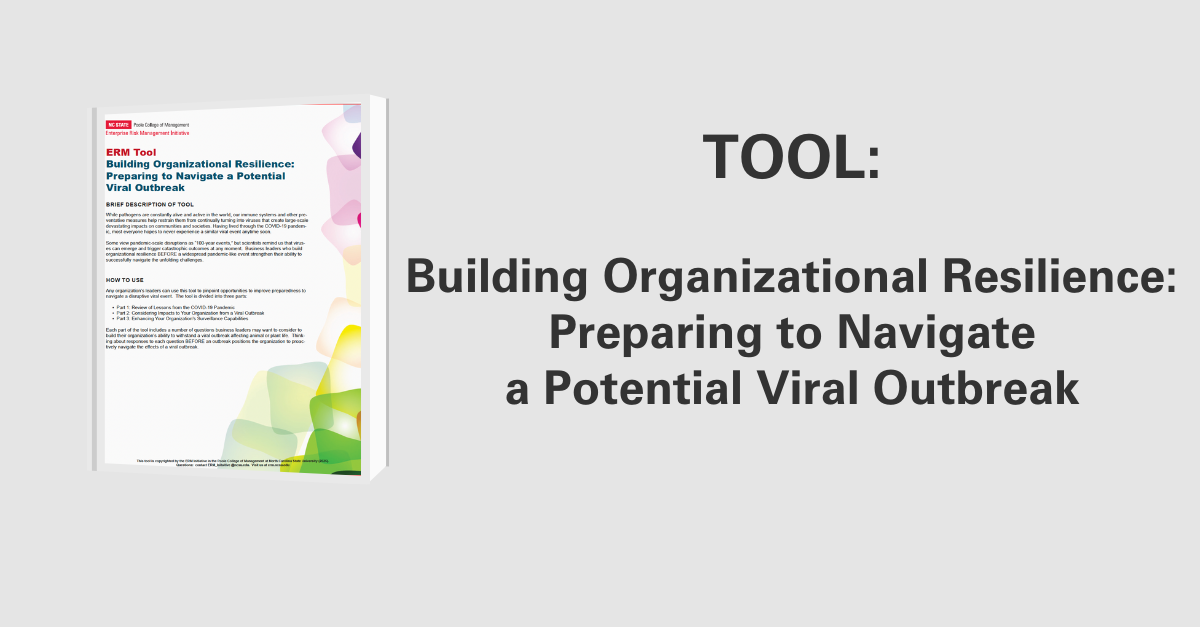Mitigating Supply Chain Disruptions and Building Resilience
Article Summary
In recent decades, global supply chains have become larger and more complex—designed for efficiency, cost and proximity to markets. At the same time, unanticipated shocks that affect global production have grown more frequent and severe, exposing vulnerabilities in the supply chains. Companies and policy makers are reconsidering how to assess, analyze and mitigate risk exposure to shocks like financial crises, terrorism, extreme weather and pandemics to ensure supply chain resiliency.
McKinsey Global Institute’s (MGI’s) Risk, Resilience and Rebalancing in Global Value Chains, explores factors leading to global supply chain risk, financial implications of shocks and guidance for building supply chain resiliency by “improving supply chain management and transparency, minimizing exposure to shocks and building their capacity to respond.”
Focusing on supply chains that produce manufactured goods, the report covers:
- Potential supply chain exposures to external shocks
- Factors that create supply chain vulnerabilities
- Expected financial losses
- Strategies to minimize the growing cost of disruptions
Supply Chain Disruptions and Exposure Risk
Global supply chain disruptions are growing in frequency and severity. The COVID-19 pandemic is the most significant global supply chain shock in recent years, but companies are increasingly facing equally extreme disruptions such as financial crises, terrorism and extreme weather. According to MGI, companies can expect a disruption lasting 1-2 months and resulting in a significant financial loss every 3.7 years.
Defining Supply Chain Risk
The risk facing any particular supply chain reflects its 1) level of exposure to different types of shocks, multiplied by the 2) underlying weakness in the supply chain as a whole.
Types of Shocks
Shocks to the global supply chain are described by the level of their severity (magnitude of impact), frequency and lead time (ability to anticipate the event). The report identifies two broad categories of global supply chain shocks, each of which can be further defined by whether or not they are unanticipated or foreseeable:
Catastrophes are “historically remarkable events that cause trillions of dollars in losses.” Catastrophes can be unanticipated or foreseeable.
- Example of unanticipated catastrophe: major hurricane
- Example of foreseeable catastrophe: global pandemic
Disruptions are serious and costly but do not cause the same cumulative toll as catastrophes.
- Example of unanticipated disruption: common cyberattack
- Example of foreseeable disruption: localized military conflict
Factors Influencing Supply Chain Exposure
Geographic footprint and factors of production determine an industry supply chain’s exposure to shocks.
Geographic Footprint
- How much of the company or industry’s current geographic footprint is found in areas prone to each type of event? Supply chains that are heavily traded are more exposed than those with lower trade intensity. Industries like semiconductors and communication equipment are also relatively concentrated, which increases exposure for the global economy.
Factors of Production
- What are the factors of production affected by the disruptions, and what are their importance to that supply chain? Heat stress, for example, is more likely to strike labor-intensive supply chains because of their relatively high reliance on manual labor. And, cyberattacks are more likely to affect supply chains with a high degree of digitization.
MGI analyzed 23 industry supply chains to assess their exposure to specific types of shocks; the resulting index can be found on Exhibit 2 of this interactive website.
Factors Creating Supply Chain Vulnerabilities
While some supply chain vulnerabilities are specific to a given industry, individual companies within an industry can experience varying levels of exposure as they rely on complex, multi-tiered and interconnected networks.
Factors influencing weakness (or resilience) within a company include the organization’s:
- Effectiveness in monitoring risk
- Implementation of mitigation strategies
- Establishment of business continuity plans
- Intentional operational decisions (e.g. how much inventory to carry)
Supplier network structure is a particularly influential factor for an individual company. In the full report, MGI provides a comparison of Dell and Lenovo (Exhibit E3) to demonstrate how even within the same industry, companies can have very different supply chain structures, often overlapping.
Key takeaways:
- Less complexity (i.e. concentration among relatively few suppliers) makes management easier but also increases vulnerability, particularly as suppliers frequently supply one another in the network.
- Layered networks (i.e. number of supplier tiers) can create blind spots, making emergent risks difficult to identify.
- The absence of substitute suppliers creates supply chain weakness.
- As with industry supply chains, geography plays a role. Suppliers concentrated in a localized area are vulnerable to natural disasters or conflicts. Geography plays a significant role, as it can impact imports and exports, production bottlenecks and other capacity constraints. Exhibit 4 in the full article demonstrates the change in geographic concentration by industry sector 2000-18; while globalization has led to diversification of some sectors, others have become more concentrated.
Financial Implications
Over the course of a decade, companies can expect disruptions to erase half a year’s worth of profits or more. MGI suggests that companies model the potential losses they could face from supply chain shocks to determine appropriate investment in mitigation.
MGI modeled two scenarios for 13 different industries:
- Scenario 1: Manufacturing shutdown lasting 100 days. Raw material delivery is hit, but distribution networks still up and running. Revenue is hit once safety stock is depleted.
- Scenario 2: Same as scenario 1, but distribution channels also affected, so unable to deliver existing inventory.
Key takeaways:
- A single prolonged production-only shock could wipe out between 30-50 percent of one year’s EBITDA for most companies.
- Inventory levels can be a key buffer when experiencing a shock that impacts supplier, but not distribution, networks.
- Low fixed costs can mitigate exposure when a disruption outlasts even safety stock.
Building Supply Chain Resilience
Brexit. US–China trade tensions. The COVID-19 pandemic. These are just three recent supply chain disruptions that make the case for proactively building supply chain and operational resilience. Smart investments in this area can be a “win-win” by not only minimizing future losses but also driving innovation, optimizing digital capabilities and improving productivity. Also, taking steps to audit and bolster your supply chain can also unearth ways to reduce carbon intensity, raise environmental and labor standards and grow opportunities for minority- and women-owned businesses.
93 percent of supply chain executives responding to a 2020 McKinsey survey reported they plan to take steps to make their supply chains more resilient.
MGI highlights three approaches to build global supply chain resilience:
- Strengthen supply chain risk management and improve end-to-end transparency.
- Create a comprehensive view of your supply chain to identify hidden weaknesses.
- Collaborate with your operations and production teams, as well as your tier-one suppliers, to create transparency.
- After you map your upstream suppliers, work to understand your production footprint, financial stability and business continuity plans.
- Minimize exposure to shocks.
- Step up your investment in tools to mitigate the impact of unanticipated and expected supply chain disruptions.
- Increase investment in cybersecurity.
- Build greater redundancy into supplier networks, including identifying, prequalifying and onboarding backup vendors.
- Design products with common components.
- Bolster physical assets to withstand natural disasters.
- Respond quickly when shocks occur.
- Strike a balance between “just-in-time” and “just in case,” which includes storing a safety stock to act as a critical buffer.
- Proactively create the ability to reroute components and flex production across sites.
- Focus on cash management to enable options such as giving key vendors a temporary lifeline amid disruptions.
Looking Ahead: Will global supply chains shift across borders?
Modern global supply chain networks are highly interconnected—and for a multitude of reasons. In this environment, is there a case to be made for shifting geographies to build resilience?
MGI conducted an analysis, considered both economic and noneconomic factors and estimated that 16 to 26 percent of exports, worth $2.9 trillion to $4.6 trillion in 2018, could be in play over the next five years. This includes supply chains 1) reverting to domestic production, 2) nearshoring, and/or 3) new rounds of offshoring to new locations.
The full MGI article includes the detailed analysis by industry of the feasibility, value and drivers of geographic supply chain shifts.


